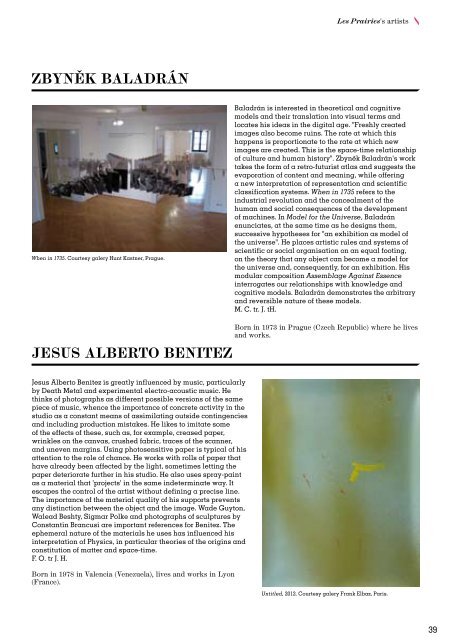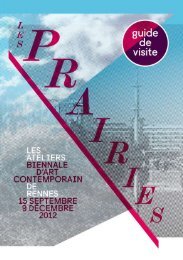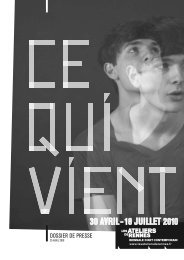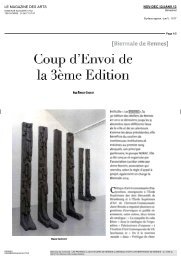Download here the Visitor's guide. - Les Ateliers de Rennes
Download here the Visitor's guide. - Les Ateliers de Rennes
Download here the Visitor's guide. - Les Ateliers de Rennes
You also want an ePaper? Increase the reach of your titles
YUMPU automatically turns print PDFs into web optimized ePapers that Google loves.
ZBYNěK BALADRáN<br />
When in 1735. Courtesy galery Hunt Kastner, Prague.<br />
JESUS ALBERTO BENITEZ<br />
Jesus Alberto Benitez is greatly influenced by music, particularly<br />
by Death Metal and experimental electro-acoustic music. He<br />
thinks of photographs as different possible versions of <strong>the</strong> same<br />
piece of music, whence <strong>the</strong> importance of concrete activity in <strong>the</strong><br />
studio as a constant means of assimilating outsi<strong>de</strong> contingencies<br />
and including production mistakes. He likes to imitate some<br />
of <strong>the</strong> effects of <strong>the</strong>se, such as, for example, creased paper,<br />
wrinkles on <strong>the</strong> canvas, crushed fabric, traces of <strong>the</strong> scanner,<br />
and uneven margins. Using photosensitive paper is typical of his<br />
attention to <strong>the</strong> role of chance. He works with rolls of paper that<br />
have already been affected by <strong>the</strong> light, sometimes letting <strong>the</strong><br />
paper <strong>de</strong>teriorate fur<strong>the</strong>r in his studio. He also uses spray-paint<br />
as a material that 'projects' in <strong>the</strong> same in<strong>de</strong>terminate way. It<br />
escapes <strong>the</strong> control of <strong>the</strong> artist without <strong>de</strong>fining a precise line.<br />
The importance of <strong>the</strong> material quality of his supports prevents<br />
any distinction between <strong>the</strong> object and <strong>the</strong> image. Wa<strong>de</strong> Guyton,<br />
Walead Beshty, Sigmar Polke and photographs of sculptures by<br />
Constantin Brancusi are important references for Benitez. The<br />
ephemeral nature of <strong>the</strong> materials he uses has influenced his<br />
interpretation of Physics, in particular <strong>the</strong>ories of <strong>the</strong> origins and<br />
constitution of matter and space-time.<br />
F. O. tr J. H.<br />
Born in 1978 in Valencia (Venezuela), lives and works in Lyon<br />
(France).<br />
<strong>Les</strong> Prairies's artists<br />
Baladrán is interested in <strong>the</strong>oretical and cognitive<br />
mo<strong>de</strong>ls and <strong>the</strong>ir translation into visual terms and<br />
locates his i<strong>de</strong>as in <strong>the</strong> digital age. "Freshly created<br />
images also become ruins. The rate at which this<br />
happens is proportionate to <strong>the</strong> rate at which new<br />
images are created. This is <strong>the</strong> space-time relationship<br />
of culture and human history". Zbynek ̌<br />
Baladrán's work<br />
takes <strong>the</strong> form of a retro-futurist atlas and suggests <strong>the</strong><br />
evaporation of content and meaning, while offering<br />
a new interpretation of representation and scientific<br />
classification systems. When in 1735 refers to <strong>the</strong><br />
industrial revolution and <strong>the</strong> concealment of <strong>the</strong><br />
human and social consequences of <strong>the</strong> <strong>de</strong>velopment<br />
of machines. In Mo<strong>de</strong>l for <strong>the</strong> Universe, Baladrán<br />
enunciates, at <strong>the</strong> same time as he <strong>de</strong>signs <strong>the</strong>m,<br />
successive hypo<strong>the</strong>ses for "an exhibition as mo<strong>de</strong>l of<br />
<strong>the</strong> universe". He places artistic rules and systems of<br />
scientific or social organisation on an equal footing,<br />
on <strong>the</strong> <strong>the</strong>ory that any object can become a mo<strong>de</strong>l for<br />
<strong>the</strong> universe and, consequently, for an exhibition. His<br />
modular composition Assemblage Against Essence<br />
interrogates our relationships with knowledge and<br />
cognitive mo<strong>de</strong>ls. Baladrán <strong>de</strong>monstrates <strong>the</strong> arbitrary<br />
and reversible nature of <strong>the</strong>se mo<strong>de</strong>ls.<br />
M. C. tr. J. tH.<br />
Born in 1973 in Prague (Czech Republic) w<strong>here</strong> he lives<br />
and works.<br />
Untitled, 2012. Courtesy galery Frank Elbaz, Paris.<br />
39






